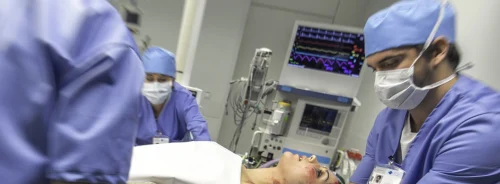ICU Management & Practice, Volume 18 - Issue 1, 2018
Interventions intended to support one organ can have
unexpected implications on the patient, presenting physicians with
critical decisions. These can be aided with innovative technologies and
new techniques, but only if well understood. We often come across
multiple organ dysfunction syndrome (MODS), with incremental degrees
of physiologic derangements in individual organs, which should be seen
as a continual process, requiring a harmonised, multidisciplinary
approach to management.
Darryl Abrams and colleagues start us off on our Cover Story journey into multiple organ support, with their discussion on the need to understand how devices intended for support of one organ can have an indirect impact on other organs—an important consideration given renewed interest in novel extracorporeal technolo- gies as a means of supporting individual organ failures. As devices evolve to offer simultaneous support for multiple organ failure, it will be important to emphasise a multidisciplinary approach at centres capable of performing both extracorporeal and advanced non- extracorporeal management strategies.
This
takes us to the next article in our Cover Story from Claudio Ronco and associates. They describe the concept of extracorporeal organ support
(ECOS) for treatment of combined organ dysfunction in critical illness
and suggest creation of a new generation of ECOS equipment with
integrated features to avoid artificial organ negative cross-talk.
Darryl Abrams and cohorts then take us to the topic of chronic respiratory
dialysis, providing us with a focus on the potential of extracorporeal
carbon dioxide removal techniques to manage chronic hypercapnic
respiratory failure. From here, we move on to devices for the heart,
with Nadia Aissaoui and colleagues providing guidance for understanding
the physiology of mechanical assist devices, their functioning,
potential complications and their management.
In our
Series section on gases, Luis Morales-Quinteros and cohorts provide a
focus on the potent effects that carbon dioxide exerts on lung biology,
which could be particularly relevant in patients with acute respiratory
distress syndrome (ARDS).
Moving on to our Matrix, we
start with an article from Velma Herwanto and associates, which provides
an over- view of the recent advances in the diagnosis and treatment of
immune system dysfunction in sepsis. Following this, Raimund Helbok and Ronny Beer review the evidence supporting the use of hypothermia in neurocritical care patients
beyond care after cardiac arrest. Here, they look at ongoing clinical
trials of targeted temperature management for neurocritical care and
provide some thoughts for designing future studies.
Shashank Patil and Fiqry Fadhlillah then provide us with a review of invasive
and noninvasive devices that can be used to monitor intracranial
pressure, following which Isabel Gonzalez provides a brief report on
compli- cations of decompressive craniectomy in neurological
emergencies. Finally, Fiona Howroyd details a multi- disciplinary
collaboration to develop a communication device for tracheostomy
patients in the intensive care unit, moving from patient ideas and
innovation through to readiness for clinical trial.
In
our Management section, Lia Losonczy and colleagues provide us
with a description of the frame- work they used to create a specialised
unit, which operates with emergency department flow, and facilitates
timely transfers of critically ill patients. Following this, Andrej Michalsen looks at variation in end-of-life care (EOLC), and asks
whether we need yet another standard operating procedure, or whether a
roadmap would be better to harmonise EOLC across institutions and,
perhaps, healthcare systems. Miriam Poggioli and colleagues then engage
in a brief discussion on the importance and the state of the art of
simulation in anaesthesia and intensive care medicine, after which John Dale-Skinner moves our focus onto the practicalities of being an
expert witness and what qualities are needed to succeed in this
important role.
Our next article is from Karen Jones,
who discusses the role of the chaplain as a resource for ethically
competent support and compassionate caring for patients. After this,
John Welch and colleagues present us with a focus on the joining of the
International Society for Rapid Response Systems with the Patient Safety
Congress in July 2018 to develop new approaches to managing patients at risk of deterioration.
In our Interview section, Jukka Takala discusses with- us how to provide better intensive care with a systems approach and individualised care, followed by an inter- view with Elie Azoulay with a focus on whether we can do a better job caring for critically ill immunocompromised patients.
I hope you find this issue stimulating. If you would like to get in touch with me, please feel free to email me at
Jean-Louis Vincent







